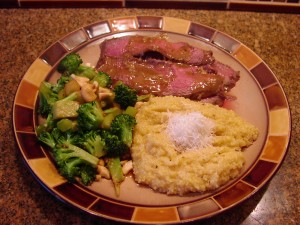So, this lady walks into a restaurant one evening, sits down in a booth and she and her husband order drinks while they peruse the menu. (This was quite a few years ago when the lady was not nearly as sophisticated or food savvy as she is today.) So on the menu, appearing with the entrée she had chosen, was this item calling itself polenta. No explanation as to what polenta was! Just polenta! (Like from birth everyone should know about polenta?!) Well this poor woman had no idea what she was ordering and too embarrassed to ask the waiter. (Did I mention this was quite some time ago?)
When her dinner arrived, she was quite taken aback by what appeared to be a square of semi-baked cornbread. But being the adventurous type, she cut off a small piece and popped it into her mouth. Well this woman had been making and eating cornbread for years. But this yellow stuff on her plate was so lacking in flavor and had such a strange consistency that she didn’t finish her serving or even try polenta again for years. All she could hope for was that polenta would go the way of those red pickled crab apple slices that used to “grace” every restaurant plate in America!
But then one magical day polenta was on the menu at one of her favorite Italian restaurants. She was mystified. “What in the name of coarse ground cornmeal had polenta to do with such a prestigious world cuisine?” But being a little older and a little bolder (notice wiser was not mentioned) she got an earful when she asked that very same question of her waiter. Because, began the waiter in his best professorial voice, “please allow me to quote from an article I just read on the Life in Italy website”. And I quote, “It often happens that a nation of people will identify themselves as a distinct culture by their traditional foods. For Italians, it always seems both pasta and pizza are the cornerstones of what makes Italian food “Italian”. However, there is a staple food of Northern Italy that does not get the recognition, but certainly makes up the third aspect of the Italian food trinity: Humble, yet versatile and satisfying polenta. Italian cuisine has been characterized by being the food of the peasant and just as poor Southern Italians worked the fields with their bellies full of pasta, Northern Italians subsisted on little more than polenta for centuries. In this way, polenta is truly an Italian national dish, and may have a history much more ancient than either pizza or pasta.”
So knowing that the chef in this restaurant would never steer her wrong, she once again ordered an entrée that included polenta. But this time, the experience was far different. The creamy, savory, and buttery polenta was served as a base for her entrée meat which lay gently nestled on top. She had discovered heaven that evening in the form of an Italian classic. (Had she realized polenta was Italian to begin with, she might have given it a second try much sooner!) But she had thought, incorrectly of course, that polenta was just a new creation some famous chef had invented and every restaurant from Denny’s to Rosellini’s Four-10 now wanted to feature. (She has since learned that when it comes to food, there is truly nothing new under the sun!) So from that wonderful evening at one of her favorite Italian restaurants, she has truly come to love this humble Italian peasant food. And this recipe from Alton Brown is her favorite. Buon Appetito!
- 2 T. olive oil
- 3/4 c. finely chopped red onion
- 1 tsp. kosher salt
- freshly ground black pepper
- 2 cloves garlic, finely minced
- 1 qt. chicken stock
- 1 c. coarse ground cornmeal
- 3 T. butter
- 2-oz. finely grated Parmesan (about ½ cup packed) + extra for serving at the table (some people, like Mr. C. for example, enjoy a little polenta with their Parmesan!)
In a large, oven-proof covered saucepan heat the olive oil over medium heat. Add the onion, salt, and pepper; sauté until the onion begins to turn translucent, approximately 4 to 5 minutes. Reduce the heat and add the garlic. Sauté until the garlic releases its aroma, about 1 minute. Add the chicken stock and bring to a boil. Reduce heat a bit and gradually whisk in the cornmeal. Cover the pan and bake in a pre-heated 350 degree oven for 30 to 35 minutes, stirring every 10 minutes to prevent lumps. Once the polenta is creamy, remove from the oven and add the butter and Parmesan. Adjust seasoning and serve immediately. Or, if you prefer, pour into a 9×13-inch pan lined with parchment paper. Cool to room temperature, then refrigerate. When ready to serve, cut into squares, rounds, or triangles, brush with olive oil and sauté in a non-stick pan. (Great way to serve leftovers too!) Polenta is gluten free and can be prepared with vegetable stock for a vegetarian side dish.

